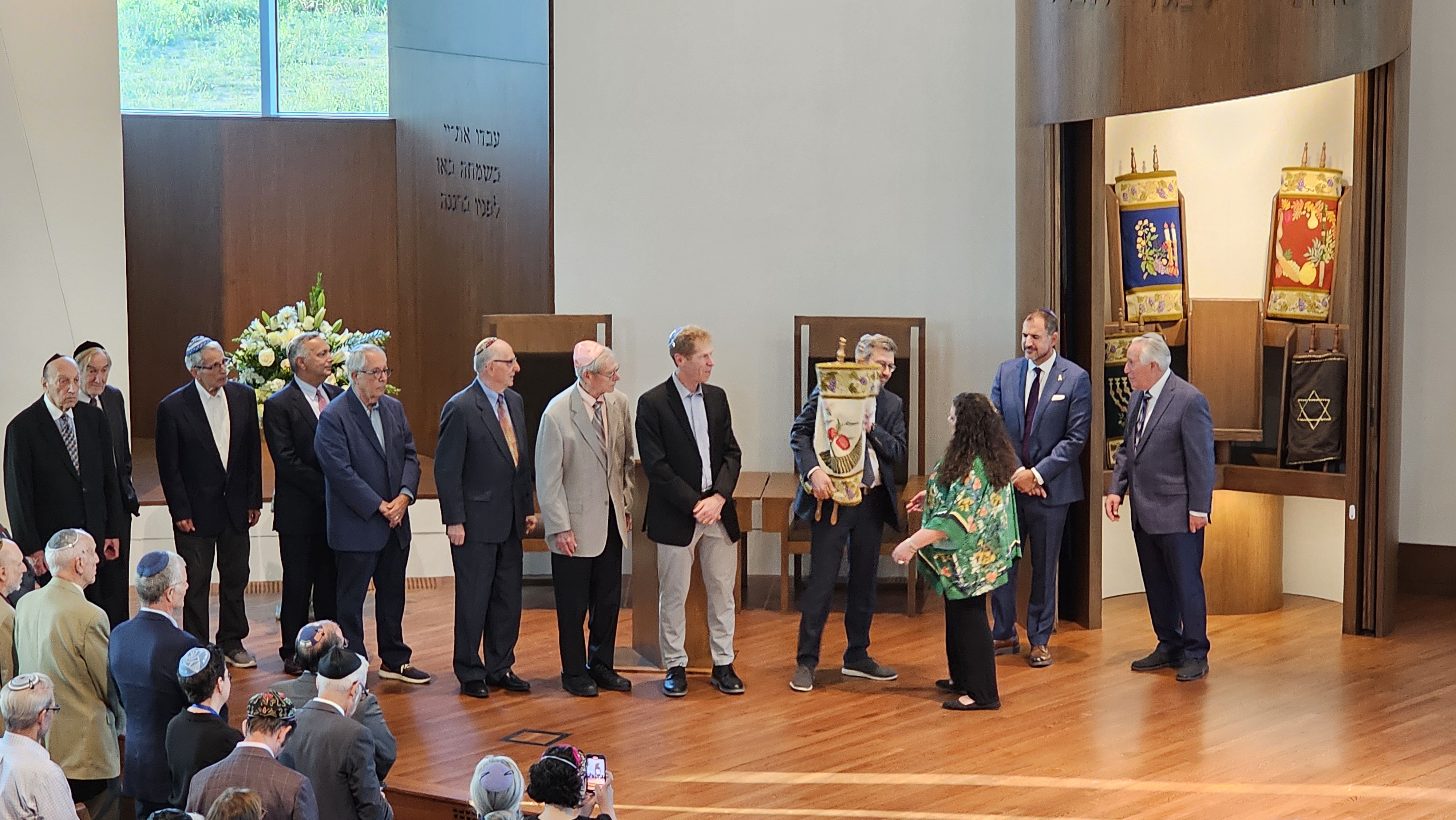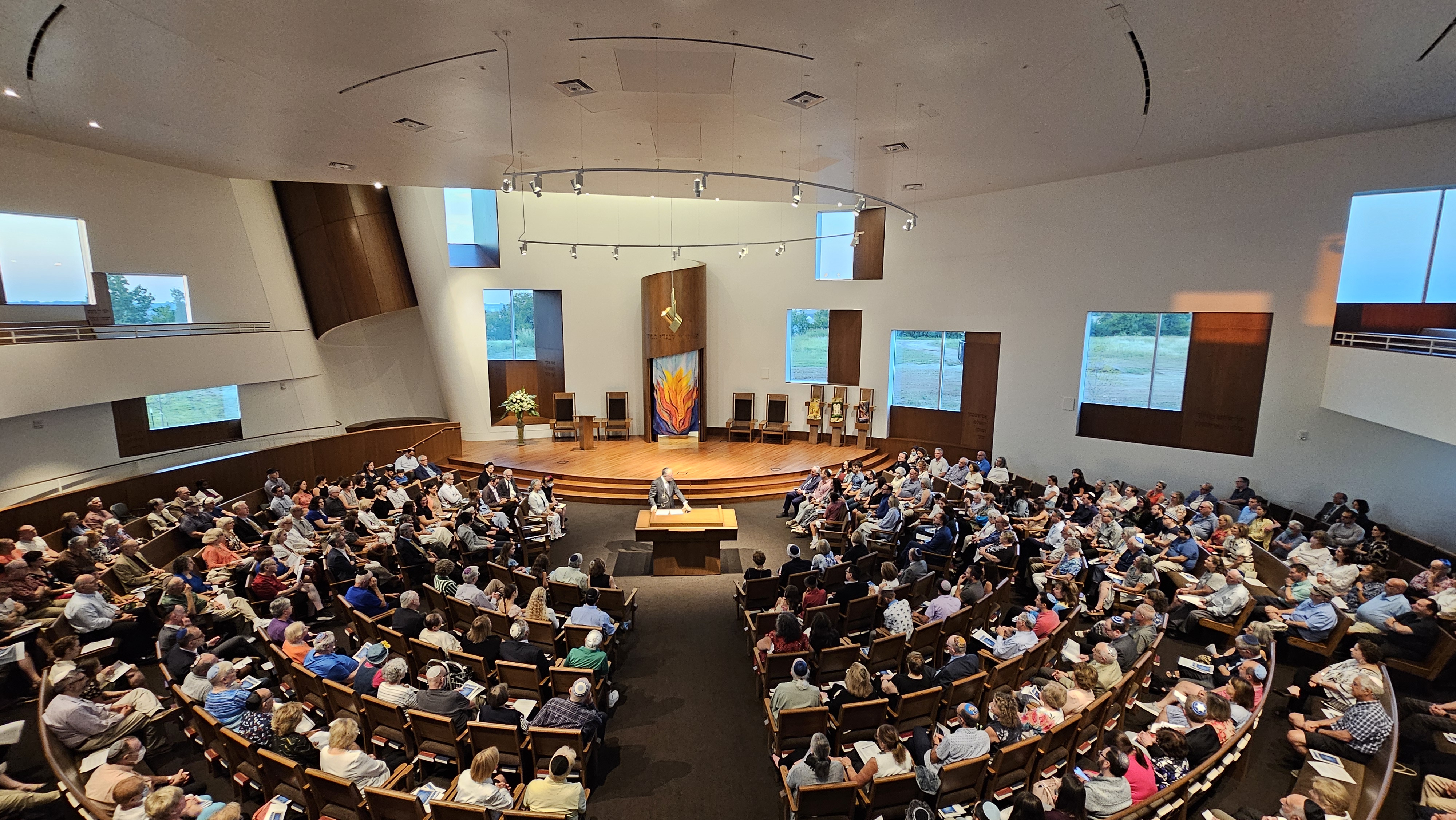Congregation Beth Shalom has completed its new sanctuary, concluding a yearslong endeavor to provide the synagogue a permanent prayer space.
The congregation held a dedication ceremony on Aug. 28 to showcase the synagogue’s new addition and honor those who helped with its realization.
The ceremony capped more than a dozen years of work to get Beth Shalom a sanctuary at its current location. The idea and process behind its construction stretches back to 2011, when Beth Shalom moved its religious functions from its previous location at 95th Street and Wornall Road in Kansas City, Missouri, to its current location at 14200 Lamar Avenue in Overland Park, Kansas. Since then, Beth Shalom has had no permanent sanctuary, using Goldsmith Hall, its large multipurpose room, as its main prayer space.
“I am thrilled that Beth Shalom now has an inspiring and unique sacred space in which to worship, celebrate and connect with the divine and with each other. Many people gave countless hours to make this dream a reality. I am grateful to all of them and to our very generous donors,” Gina Kaiser told The Chronicle. Kaiser has been the chair of Beth Shalom’s Sacred Space Steering Committee since its conception and is a member of the sanctuary fundraising and construction committees.
“After years of planning, fundraising, a stop due to COVID, value engineering after COVID due to large cost increases, construction delays and many other issues, finally and joyfully… [we can enjoy] what we have created,” Kaiser said at the ceremony.
The new sanctuary, built as an addition to the synagogue, departs from the rest of the building’s architectural design. The exterior, clad in corrugated metal panels, is designed to look like an unfurling Torah scroll, with two cylindrical towers representing the Torah’s poles. Large rectangular windows are spread along the walls, allowing natural light to fill the sanctuary during the day.
“In some ways, this building needs no introduction,” said Victor Wishna, Beth Shalom’s president. “It’s an architectural statement, and it speaks for itself, and it is not shy. It is not a rectangular box tucked behind a strip mall — it is literally a shining bastion on a hill… a vibrant new strand in this tapestry of Kansas City’s architecture.”
“It looks as if there is a giant underneath this hill, and he’s doing hagbah, lifting a Torah scroll up over his head,” said Rabbi David Glickman, Beth Shalom’s senior rabbi.

Inside, chairs and pews are arranged in semicircular rows around the bimah, and a balcony with more seating follows the curve of the wall of the sanctuary. The centerpiece is the ark, a large wooden cylinder also shaped like a scroll. On it is an excerpt from Tehillim 16:8 in Hebrew that translates to “I have placed the Lord before me constantly.”
The ark, readers’ table and furniture on the bimah were all custom made by New Holland Church Furniture in New Holland, Pennsylvania. Kaiser told The Chronicle that the furniture maker worked closely with the sanctuary’s architects when designing them, and it also built the wooden chairs and pews.
The windows are flanked with wood accents, most also including inscriptions from Tehillim. The ner tamid (eternal light) above the ark was custom made by Machine Head, a metal fabrication company in Kansas City, Missouri, to match the style of the space’s architecture.
The new sanctuary also includes accessibility aids, such as a ramp up to the bimah and a height-adjustable lectern with a microphone. One of the Torah scroll mounts in the ark is lower than the others to allow people in wheelchairs to kiss the scroll.

Architects Preston Scott Cohen and Carl D’Apolito-Dworkin of Preston Scott Cohen, Inc., spoke of their design and its intent at the dedication.
“Judaism marks the passage of time with rituals that help people process what happens now, the good and the bad, through and alongside their connection to that deep path,” D’Apolito-Dworkin said. “With this building and with [the congregation], we have tried to think about how an architecture in space can interact with an architecture in time — how the building can change throughout the years and then repeat, like the experience of reading the Torah.”
D’Apolito-Dworkin said that through working with Beth Shalom members and leadership, he learned that Judaism emphasizes “the modeling of deeply held values in order to show the next generation what it means to lead a good, generous Jewish life.”
“This is why building a shul is the most meaningful architectural act I can conceive,” he said.
The culmination of years of work
Over the years, multiple committees, dozens of lay leaders and well over 200 donors helped contribute to the sanctuary.
Kaiser said at the ceremony that, with the guidance of fundraising committee chair Ron Coppaken and help from clergy, staff and the congregation, the $15 million fundraising goal was reached and the building was finished without any outstanding debts. The synagogue is still raising funds to ensure that the new sanctuary has minimal financial impact on the synagogue’s operating budget, and Kaiser said there are still donor opportunities.
Kaiser also said John Almeida, the building’s owner’s representative, and Stef Misler Williams, Beth Shalom’s executive director, were instrumental in the building process, working with general contractor A.L. Huber, architects and engineers.
The dedication ceremony also honored the memories of those who helped and supported the construction but died before its completion.
A featured speaker at the dedication was Rabbi Alan Cohen, Beth Shalom’s previous senior rabbi. He retired and moved to Florida in 2012, but he flew back to Kansas City for the ceremony.
Rabbi Cohen was involved in the project’s earliest stages. He recounted the story of Hannah Krumholz (z”l), who he said made a financial contribution that served as the basis for the new sanctuary more than a decade ago.
“The fact is that her memory will always, I think, be with us and be with Beth Shalom because of the fact that she laid… the foundation for this particular space,” Rabbi Cohen said.
Wishna shared the story of his mother, Jeanette Wishna (z”l), a past Beth Shalom president who led when the congregation broke ground for its current building in 2002. The building served as the congregation’s preschool, religious school and administration offices before religious functions were fully moved there in 2011.
“Nineteen years later, our son, Abe, the grandson that she never met, took part in the groundbreaking ceremony for this [sanctuary],” Wishna said, underlining the meaningfulness of l’dor vador (from generation to generation).
Kaiser also honored the memory of her father, Bill Kaiser (z"l), and his dedication to Judaism and Beth Shalom.
Timeliness played an additional factor in the sanctuary’s story during the last year of construction. During his closing remarks, Rabbi Glickman said that its construction has served as an inspiration to some community members during the weeks and months following Oct. 7.
“In the weeks following the devastating attack on Oct. 7, as antisemitism was on the rise, I received numerous calls and texts from people in this community saying how it inspired them and it uplifted them to see such a public, unembarrassed display of Jewish shape arising from a hill in Johnson County,” he said. “There was a Torah scroll arising from the ground in Overland Park during this otherwise dark time for the Jewish people.”
Before concluding the ceremony with a prayer he wrote, Rabbi Glickman made clear that although the construction of the sanctuary was complete, the work of the congregation is not done.
“Today begins our work to create a community inside these walls,” he said. “...[Here] we can lift each other up with our presence. We can raise each other up with our singing. We can challenge each other with our learning. We can catch up on our lives. We can connect with each other, and we can dream about the better world that we want to create outside of these windows.”




